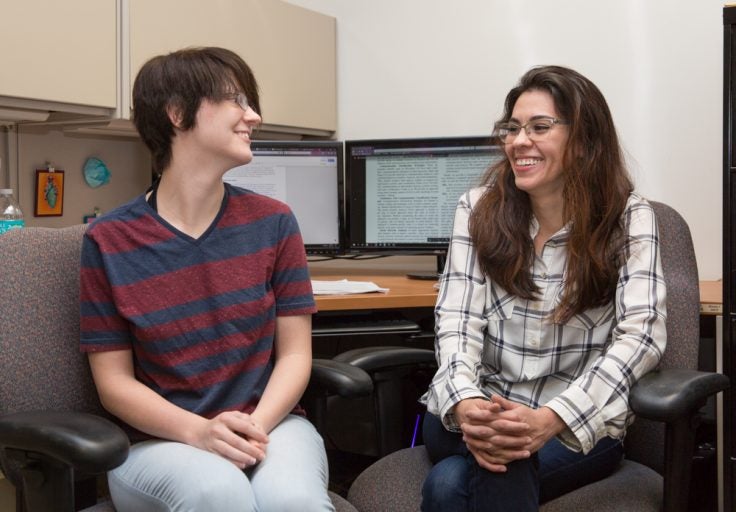Two doctoral students in the Modeling & Simulation (M&S) program have been recognized with best student paper awards for their work establishing frameworks for improving complex decision making in both humans and robots.
The research is partially funded by grants from the U.S. Army Research Laboratory and the Office of Naval Research, agencies supporting research programs to develop technologies and training that make problem solving and decision making more effective.
Stephen Fiore, a professor with UCF’s cognitive science program in the Department of Philosophy, said the work is significant because it shows how our students are learning to conduct basic science in the context of complex societal problems.
“Decision making, whether it be in collaboration with robots, or under conditions of uncertainty, continues to challenge society,” Fiore said. Our Modeling and Simulation students are getting exposure to interdisciplinary research topics that will improve collaboration between people and machines.”
Robots
Katy Odette, a first-year doctoral student, was awarded first place in the Cognitive Engineering technical group of the Human Factors & Ergonomic Society (HFES). Odette, a student under the supervision of Florian Jentsch, professor of Psychology, said her research interests were inspired by the children’s toy Cozmo the robot.
Cozmo, a square-faced bulldozer of a robot toy, communicates with his young human collaborators by nodding his head, blinking and flashing his LED eyes and throwing building block-sized boxes with his bulldozer arms.
Odette said she was so inspired by the toy’s seeming ability to connect with its user that she wanted to study what it would take to equip a real autonomous robot with the ability to express such emotions as frustration or fear when confronted with a task or situation.
Her hope is that her research will one day support artificial intelligence that can aid in the development of a military robot capable of interacting with, and helping, its human teammates to save lives.
In her paper, she proposed doing so with techniques such as reinforcements for positive behaviors, guided learning, and emotional expressions. Although other roboticists have taken similar approaches, Odette’s research is one of the first to integrate learning and expression in a way that can regulate interaction within a human-robot team.
For example, since the research is partially funded by the U.S. Army Research Laboratory Robotics Collaborative Technology Alliance (RCTA), one could imagine a robot that has been tasked with finding and deactivating bombs.
The robot could be fed historic data on likely outcomes for specific scenarios and make decisions based on that data on how to most effectively proceed into a dangerous environment.
Or a human could teach a robot one-on-one what action to take if there is a potential for being fired upon. The robot could be programmed to respond to a human’s cue to duck, push a button to attack or hide. Or alternatively, the robot could pick up on external threats and warn the human via an expression of danger or confusion.
In her paper, Odette pointed out the specific challenges of training a robot to respond like a human to a human, including the need to reverse engineer the fundamentals of human learning and program those variables into a robot. This work helps to develop a kind of artificial social intelligence to help robots understand how to collaborate with teammates. She said it is the challenge that makes her work exciting.
Visualization Tools
Olivia Newton, a second-year doctoral student, received second place from the same technical group of the society for her paper examining the development of visualization tools, such as color coded maps containing intelligence information, to help mitigate uncertainly when making decisions.
“Modern day operations such as the military or healthcare make up complex socio-technical systems,” Newton said. “There are lots of uncertain pieces of information that must be taken into account when solving problems and making decisions. This research is studying the technology to support that kind of real-world decision making.”
Most people can relate to weather maps for major systems such as hurricanes that use a color coded method to illustrate the likelihood of such an extreme events happening in a particular area.
Newton is dealing with even more complicated data sets, with maps using differing visual aids to display a wide variety of information, such as locations of boat and air traffic around a port. The goal is to devise methods that could be used by decision makers to more effectively tell, at a glance, if there is, for example, illegal activity like drugs being offloaded in the area.
Fiore, who serves as Newton’s advisor on the project, said the overriding objective in the work is the improvement of cognition as it relates to any type of complex human task.
Fiore noted that this is now a 5-year student paper award winning streak in the Cognitive Engineering technical group of HFES. Modeling and simulation students took first and third place in 2016, first place in 2015 and 2014, and second place in 2013.
“These awards are an important recognition of the UCF’s modeling and simulation students,” Fiore said, “and show they have the talent to contribute to the future of improved technologies that augment cognition and can help solve the kinds of complex problems facing society in the modern age.”
